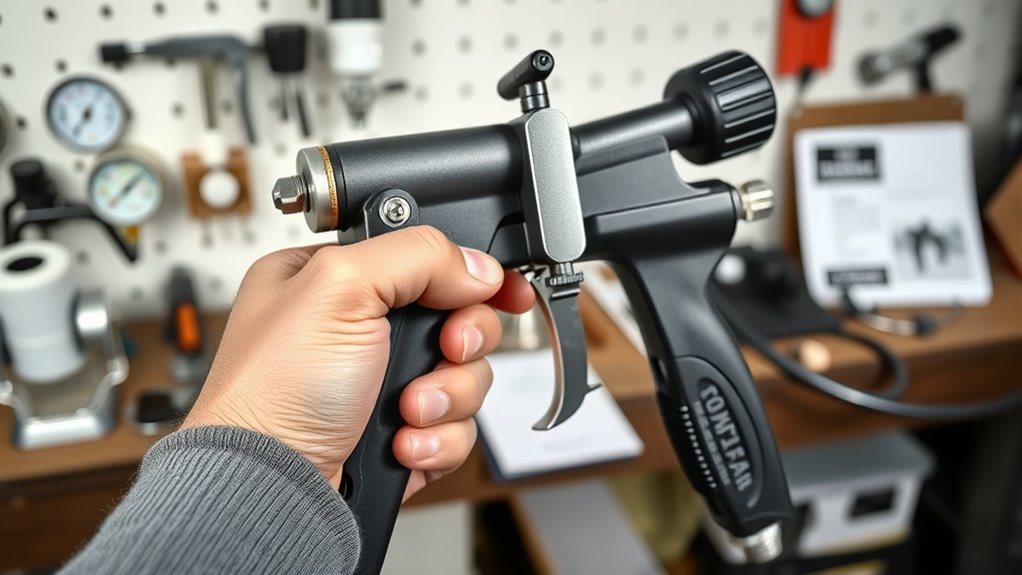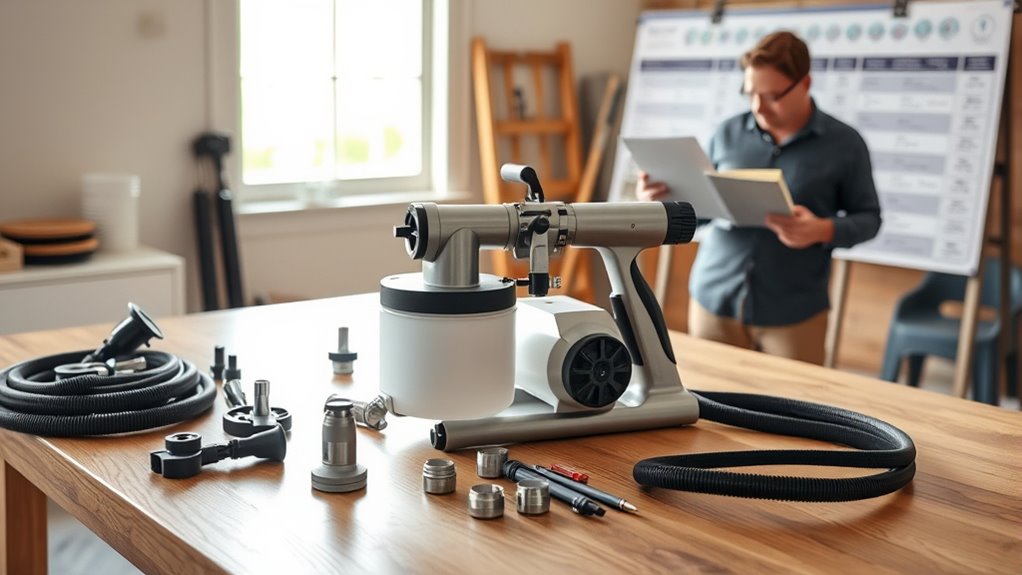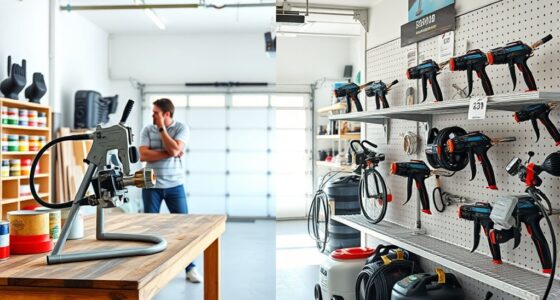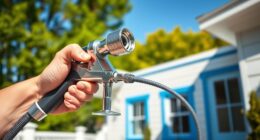When buying your first airless sprayer, focus on paint compatibility, ensuring it handles the types of paint you plan to use. Consider your power source, like electric or gas, based on project size and mobility needs. Look at pressure capacity and flow rate to match your coverage speed, and choose a model that’s easy to operate and maintain. Thinking about your project scale and tools will help you pick the right sprayer—keep exploring to find out more tips.
Key Takeaways
- Ensure the sprayer is compatible with your intended paint types to prevent clogging and ensure proper application.
- Choose a power source (electric, gas, or battery) based on project size, portability needs, and environment.
- Consider pressure capacity and flow rate to match the scale of your projects for efficient and even coverage.
- Opt for models with easy setup and maintenance features to save time and reduce hassle during use.
- Assess project scope and portability needs to select a sprayer that offers the right balance of power, size, and versatility.

Buying your first airless sprayer can seem overwhelming with so many options available, but understanding the key factors can make the process much easier. One of the most important considerations is paint compatibility. Not all sprayers work with every type of paint, so you need to check the manufacturer’s specifications carefully. Some sprayers are designed for thicker paints like latex or elastomeric coatings, while others are better suited for thinner stains or lacquers. If you plan to paint surfaces with different types of finishes, look for a sprayer that can handle a variety of materials without clogging or losing pressure. This guarantees you won’t have to buy multiple units or frequently change equipment, saving you time and money.
Another vital factor is the power source options. Airless sprayers come in different configurations—electric, gas-powered, or battery-operated. Electric models are typically more compact, quieter, and easier to maintain, making them ideal for smaller projects or indoor use. Gas-powered sprayers, on the other hand, offer greater mobility and are better suited for large-scale jobs or outdoor projects where access to power outlets is limited. Battery-operated sprayers provide the convenience of cordless operation with decent mobility, but they might have limited runtime depending on the battery capacity. Your choice depends on the size of your projects, your work environment, and your preference for portability versus power.
Choose between electric, gas, or battery-powered sprayers based on project size and mobility needs.
Additionally, consider the sprayer’s pressure capacity and flow rate, which directly impact how quickly and smoothly your paint is applied. Higher pressure and flow rate mean faster coverage, but they also require more robust equipment and can be more challenging to control. If you’re just starting out, a model with adjustable pressure settings can give you better control and help you learn how to manage the spray pattern effectively.
It’s also beneficial to be aware of Mazda Tuning options that can enhance your equipment’s performance and longevity, ensuring you get the best results from your sprayer over time.
Ease of use and maintenance are also key. Look for a sprayer with straightforward setup and cleaning procedures. Features like a removable spray tip, easy-access filters, and durable hoses can save you headaches during and after your project. Moreover, consider the weight and ergonomics of the unit, especially if you anticipate working on large surfaces or overhead areas. A lightweight, well-balanced sprayer reduces fatigue and increases precision.
Frequently Asked Questions
Can I Use an Airless Sprayer for Both Indoor and Outdoor Projects?
Yes, you can use an airless sprayer for both indoor versatility and outdoor suitability. Many models are designed to handle different surfaces and paint types, making them perfect for various projects. Just guarantee you select a sprayer with adjustable pressure settings and compatible tips. This way, you’ll achieve smooth finishes indoors and efficiently cover larger outdoor areas, saving you time and effort on all your painting tasks.
How Loud Is an Airless Sprayer During Operation?
The noise levels of an airless sprayer can be deafening, comparable to a jet engine taking off. During operation, the sound intensity generally ranges between 80 to 90 decibels, which is loud enough to require hearing protection. It’s important to take into account this noise level, especially if you’re working in enclosed spaces or around others, to ensure safety and comfort while completing your painting projects.
What Safety Gear Is Recommended When Using an Airless Sprayer?
When using an airless sprayer, you should wear protective clothing to prevent paint contact and respiratory protection like a mask or respirator to avoid inhaling fumes or overspray. Safety goggles or a face shield also help protect your eyes. Always follow manufacturer instructions and local safety regulations. Proper gear keeps you safe from paint splatters, fumes, and potential skin irritation, ensuring a safer and more efficient painting experience.
How Often Should I Clean and Maintain My Airless Sprayer?
You should clean and maintain your airless sprayer after every use to keep it in top shape. Follow a regular cleaning schedule, including flushing the system with water or solvent, depending on the paint type. Maintenance tips include checking for clogs, inspecting hoses, and lubricating moving parts. Proper cleaning and maintenance prolong your sprayer’s lifespan and ensure smooth operation on each project.
Are There Eco-Friendly or Low-Voc Options Available for Airless Sprayers?
Yes, there are eco-friendly coatings and low VOC options available for airless sprayers. You can choose sprayers compatible with low VOC paints, which reduce harmful emissions and odors. Look for models that support eco-friendly coatings to minimize environmental impact. By selecting these options, you guarantee safer indoor air quality and a more sustainable painting process, making your project both environmentally responsible and effective.
Conclusion
Choosing the right airless sprayer can make or break your painting project. Remember, over 60% of DIYers report faster completion times with the right equipment, saving both time and money. By considering factors like power, size, and nozzle options, you’ll guarantee a smooth, professional finish. Investing in the right sprayer now means fewer frustrations later, turning your painting task into a satisfying, efficient experience. Happy sprayer shopping!









